
views
Cooking the Asparagus
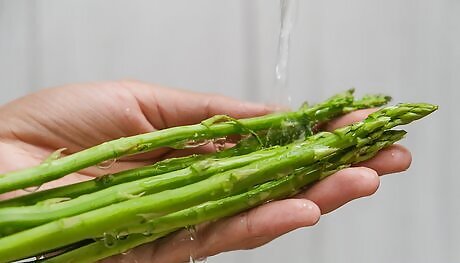
Wash your asparagus in cool water to remove superficial dirt. Before you blanch your asparagus, make sure it is clean. Hold the stalks underneath cool water from your sink for 10-30 seconds.
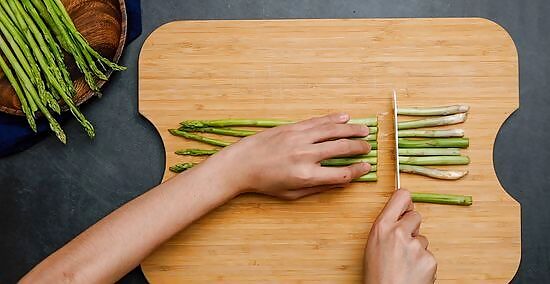
Trim the ends off of your asparagus. To easily chop off the ends, place the asparagus on a cutting board so all of their ends are aligned. Then, use a large, sharp knife to slice off the bottom fourth of the asparagus stems. Remove the white, thick end from the green, slim stalk. Make 1 chop across all of your ends to easily remove it. The ends are less flavorful and chewier, making them undesirable to eat.

Bring a large pot of water to a boil using a high heat setting. To blanch your asparagus, fill a large pot about halfway full with water from your sink. Then, place the pot on your stovetop and select a high heat setting. Your water should come to a boil in about 5 minutes.

Add salt to your water if you want to enhance the flavor. Sprinkle your salt into the water as soon as you turn on the heat. Use about 2 tablespoons (29.6 grams) per 6 cups (1,400 millilitres) of water. While adding salt is optional, it helps season the asparagus and help it retain nutrients.

Put your asparagus in the water once it starts to boil. After you see bubbles brewing from your pot, place your clean, trimmed asparagus into the water using your hands. Then, use a slotted spoon or pair of tongs to submerge the asparagus completely in the water. As you do this, be careful not to burn yourself on the hot pot or from the steam.
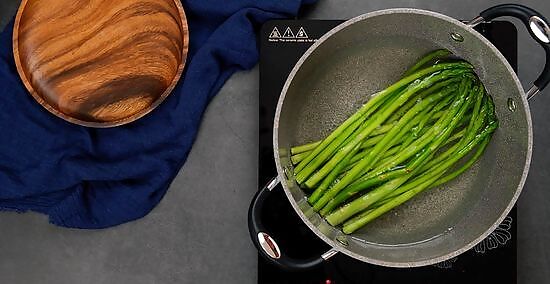
Let the asparagus cook for 2-4 minutes. Your asparagus will be fully cooked in roughly 3 minutes. As they cook, keep an eye on the color of the asparagus. Your asparagus is ready when the stalks are bright green.
Submerging the Asparagus in Ice Water
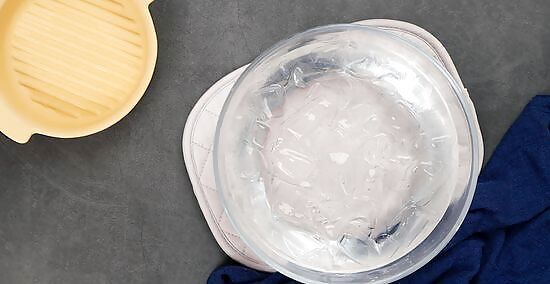
Prepare an ice bath as the asparagus is cooking. After you place the asparagus in boiling water, grab a large bowl and fill it with ice. Then, cover the ice in cold water from your sink. Place the bowl next to the stovetop so you can easily transfer the asparagus.
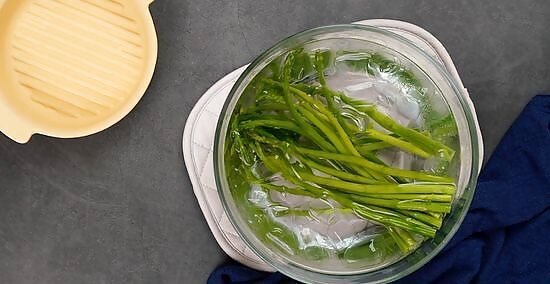
Transfer the asparagus to an ice bath immediately after it cooks. After about 3 minutes or so, grab your tongs and pinch your asparagus with them. Ensure the asparagus is a bright green color before you take it out of the boiling water. As soon as you lift the asparagus out of the water, drop it into your bowl of ice water. Soak the asparagus for about 1-3 minutes until it is cooled down completely. If you overcook your asparagus, it will get soggy and turn a shade of dark green. The cold water stops the cooking process and softens your asparagus.

Set the asparagus on a clean towel after about 3 minutes. After the asparagus cools down, remove it from the ice water and place it on a clean kitchen towel or paper towel. Pat the stalks dry to remove the excess water.
Serving and Storing the Asparagus
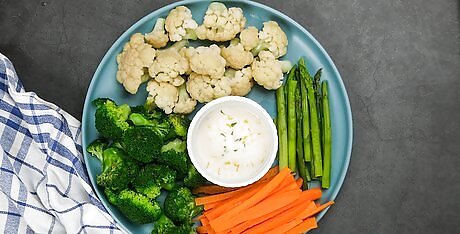
Eat your blanched asparagus plain if you want a healthy snack or side. After your asparagus is dry, you can simply grab a fork and dig in! Sprinkle a little salt and pepper on top if you’d like some extra flavor. For example, you can serve your plain asparagus with a veggie tray for a yummy appetizer. Add fresh carrots, celery, broccoli, and cauliflower for a full spread. Don’t forget the veggie dip!

Chop up your asparagus if you want to put it in a salad. Take your sharp knife, and chop your asparagus into bite-sized pieces. Then, toss the bits with chopped romaine and/or spinach. Add toppings like dried cranberries and goat cheese for a yummy, healthy dish. You can add asparagus to any salad you’d like!
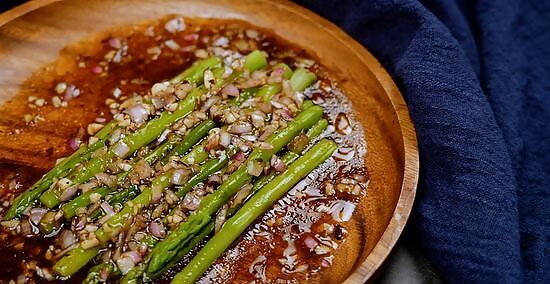
Cover your asparagus with balsamic vinegar if you want a tasty sauce. To do this, place your asparagus on a serving platter or onto individual serving plates. Whisk up 3 tablespoons (44.4 millilitres) of balsamic vinegar, 2 tablespoons (29.6 grams) minced of red onion, 2 tablespoons (29.6 millilitres) of olive oil, 1 clove of minced garlic, and a sprinkling of black pepper. Then, pour the mixture over top of your asparagus. This makes a delicious side dish or appetizer. This mixture is great for 4 servings of asparagus. To serve your asparagus warm, throw the mixture into a medium-sized skillet and heat it up for 2-3 minutes.
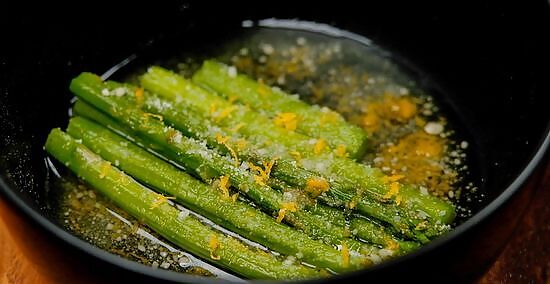
Serve the asparagus with olive oil and Parmesan for a yummy topping. Put your asparagus into a bowl, and mix in 2 tablespoons (29.6 millilitres) of olive oil, 2 tablespoons (29.6 grams) of grated Parmesan cheese, and 1 teaspoon (4.9 grams) of lemon zest. Sprinkle in salt and pepper to taste, if you’d like. Mix the ingredients all together thoroughly, then serve it in a platter or individual plates. If you’d like to serve your asparagus warm, you can skip the ice bath and mix the ingredients while the asparagus is still hot.

Refrigerate your blanched asparagus for up to 3-5 days. For best results, refrigerate your asparagus within 2 hours of blanching it. Wrap the asparagus securely in plastic wrap, and place it in an airtight container, such as Tupperware. Secure the lid, and place the container inside your fridge. Eat or freeze your asparagus within about 3 days.
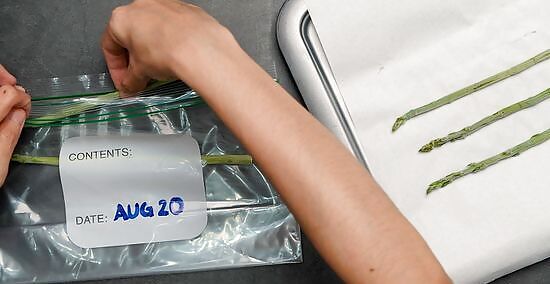
Freeze your asparagus if you want to store it long-term. Line your baking tray with parchment paper, and spread the asparagus stalks across the tray. Place the tray in your freezer for 1-3 hours until the asparagus is completely frozen. Then, take the tray out of the freezer. Pack the freezer bag full of your frozen asparagus. Then, squeeze out as much air as you can. Place the bag in your freezer, and store your asparagus for 8-12 months. When you line the tray, leave a bit of room in between the stalks. Alternatively, place your frozen asparagus in a freezer-safe container, like a Tupperware bin. You can use a marker to label the bag or container with the date you froze it, if you’d like. To cook with frozen asparagus, remove the stalks as needed.

















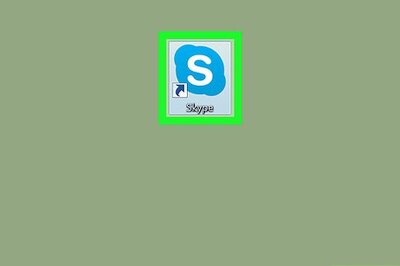


Comments
0 comment